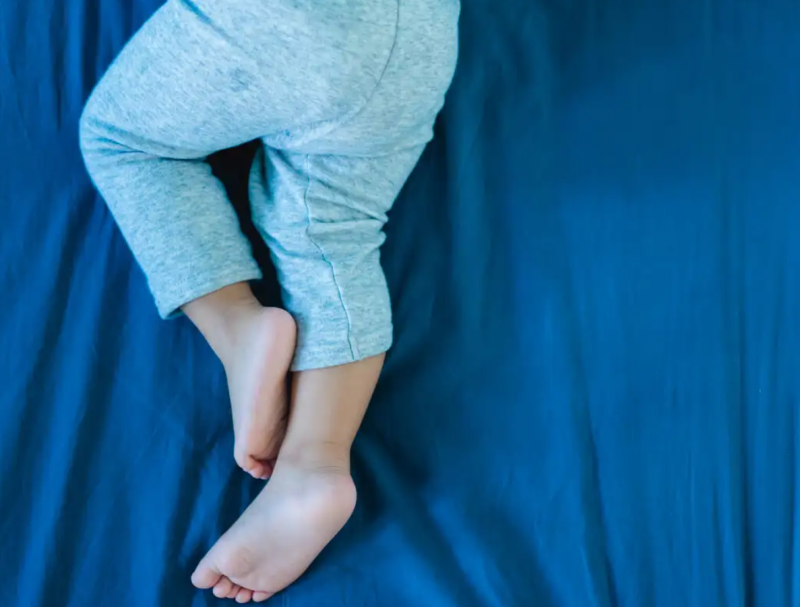
Leg pain is a common reason for medical consultation worldwide. It can appear while people are resting in bed or on the sofa, even after physical activity. Are you interested in knowing the causes of leg pain at rest? We will tell you below.
The legs comprise various muscles, ligaments, tendons, nerves, and blood vessels. These are responsible for supporting the body and allowing movement. In this sense, leg pain at rest can result from damage or disease of these anatomical structures.
In general, poor circulation, nerve compression, and varicose veins are frequent causes of discomfort in the lower limbs. In most cases, the ailments appear after several hours of lying down or with elevated legs. Early professional evaluation helps to reduce symptoms progressively.
Contents
Causes of leg pain at rest
Leg pain at rest can be localized or extend throughout the entire limb. Often this starts as a cramping or heavy feeling that increases in intensity over time. In addition, it is usually accompanied by other symptoms that facilitate the identification of the underlying disease.
1. Peripheral arterial disease
Impaired blood flow is one of the most common causes of leg pain at rest. In peripheral arterial disease, there is an imbalance between the supply and demand of blood in the extremities. This condition usually results from the narrowing the blood vessels by fatty plaques.
People with vascular disease often have cramps when walking in their calves and ankles. In advanced cases, the pain intensifies and appears even when the legs rest. Other symptoms associated with the obstruction of blood flow are the following:
- Numbness and weakness in the legs.
- Paleness and skin coldness.
- Shiny and dry skin.
- Thick yellow nails.
In the same way, the pain can appear at any time of the day and even interrupt sleep. Studies affirm that this condition is more common in people between 40 and 60, with the risk six times greater in smokers.
In cases of pain at rest of ischemic origin, it is advisable to let the foot of the bed dangle or take a few steps in the room to alleviate the discomfort temporarily. Medical treatment includes using aspirin and clopidogrel, as well as surgical revascularization.

2. Venous insufficiency
Venous insufficiency is a disease characterized by the difficulty of the veins in returning blood from the legs to the heart. In most cases, venous dilation gives rise to the appearance of varicose veins and color changes in the skin.
The pain is usually intense and worsens when the person spends much time sitting or standing. Similarly, patients often report tingling, cramps, heaviness, and swelling of the feet and ankles. In chronic cases, there is a thickening of the skin and a tendency to ulcer formation.
Some studies recommend lying on your back with your legs elevated for 30 minutes to improve venous return and relieve pain. In addition, situations of immobilization of the lower limbs or standing for long periods should be avoided.
Conservative medical treatment includes the use of compression stockings and vagotonic medications. Similarly, sclerotherapy and a surgical approach are options in advanced cases of venous insufficiency.
3. Muscle problems
The legs contain some of the largest and strongest muscles in the human body. They are subjected to high-stress levels when walking, running, or exercising. For this reason, leg pain at rest is shared due to muscle damage.
In most cases, the ailment is focused on one point on the leg and is aggravated by movement. Intense physical activity usually gives rise to small lesions in the muscle mass that manifest with pain and inflammation. The discomfort usually appears at night or in the days after exercise.
Tenosynovitis, tendonitis, and myositis are other common causes of leg pain at rest. The application of cold compresses and the use of anti-inflammatory medications usually relieve discomfort. However, professional attention should be sought if the pain worsens or persists over time.
4. Sciatic compression
Compression of the sciatic nerve often causes pain, numbness, and tingling in the back, buttocks, and legs. In this sense, herniated discs, pelvic fractures, spinal stenosis, and some tumors are frequent causes of this condition.
The pain can range from a mild ache at rest to an intense discomfort that makes movement difficult. It usually extends from the back through the thigh to the calf and the sole. Also, muscle weakness in one or both legs is common.
Self-care measures include applying hot and cold compresses, avoiding heavy lifting, and gradually resuming physical activity. Similarly, physiotherapy and infiltration with analgesic drugs can alleviate the symptoms.
5. Joint problems
Leg pain at rest sometimes results from joint inflammation or arthritis. The discomfort is often accompanied by stiffness of the affected joint and difficulty walking. Osteoarthritis is the most common form and is associated with aging cartilage wear.
Similarly, gout and rheumatoid arthritis are joint problems characterized by pain, swelling, and redness. In general, continuous medical evaluation and timely therapeutic follow-up significantly improve the quality of life.
Non-steroidal anti-inflammatory drugs (NSAIDs), such as ibuprofen and cold packs, may help relieve pain. In addition, excessive physical exertion or keeping the limb in one position for a long time should be avoided. Physiotherapy is essential in the progressive recovery of the disease.
6. Bone growth
The growth of the bones can cause discomfort in the legs of children and adolescents during their development. In most cases, it occurs in the thigh, calf, knee, and front of the leg. It affects 20% of children between 3 and 10 years of age.
The pain usually appears in the afternoon and lasts 10 to 30 minutes. The episodes can come and go and come back after a couple of weeks. Warm compresses and massages with gel or cream in the affected area relieve discomfort.

7. Pregnancy
Leg pain at rest is a common symptom in pregnant women. This results from an increase in the mother’s blood volume due to the high levels of estrogen and progesterone. The discomfort is generally similar to that of people with venous insufficiency.
On the other hand, the increase in the uterus size from the second trimester of pregnancy can cause compression of the sciatic nerve. In addition, large vessels, such as the vena cava, can also be affected, resulting in inflammation and cramps in the lower limbs.
Doctors recommend doing spinal stretching exercises and lying on your back with your lower limbs elevated to relieve leg pain during pregnancy. The pain and cramps disappear a couple of days after delivery.
When to seek medical attention if there is leg pain at rest?
Multiple conditions can cause leg pain at rest. In this sense, health professionals are the only ones trained to identify the underlying cause and provide the most appropriate treatment. In addition, an early approach improves people’s prognosis and reduces long-term risk.
Should the pain increase in intensity or other symptoms appear, care should be sought immediately. Some warning signs include fever, inability to walk, and blackish skin discoloration.